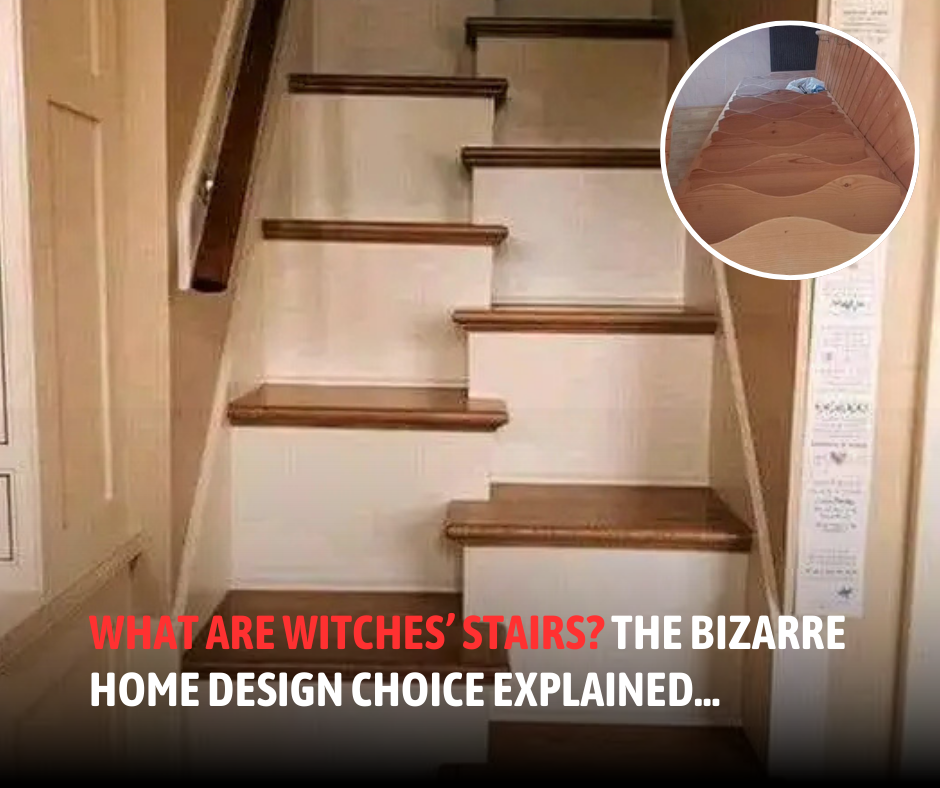Witches’ stairs, an unconventional yet intriguing architectural feature, gained popularity on TikTok a few years ago. Despite their spooky-sounding name, these stairs aren’t rooted in superstition but are a clever, space-saving design that has been around for quite some time.
Although myths have sprung up around their origin, the reality of witches’ stairs is far more practical—and interesting—than their mysterious reputation suggests.

Witches’ Stairs: Unveiling the Truth Behind the Design
The real purpose of witches’ stairs is surprisingly functional, especially in homes where space is limited. These stairs can be found in attics, tiny houses, and loft spaces, where traditional staircases would take up too much room.

Rather than being tied to ancient beliefs or supernatural folklore, witches’ stairs are an innovative solution designed to make the most of small areas. Also known as alternate tread stairs, they have earned a solid reputation among architects for their efficient use of space and their unique appearance.
How Witches’ Stairs Save Space
Witches’ stairs are designed to save space in two primary ways. First, each step is only half as wide as a conventional stair tread. Second, the steps are staggered, meaning you alternate feet as you ascend or descend. This allows the staircase to take up less room, making it an ideal choice for compact spaces like lofts or narrow attics.
The staggered design does more than just conserve space. It also ensures the staircase isn’t as wide as traditional staircases, leaving room for other purposes like extra storage. For example, the space underneath these smaller staircases can be repurposed for bookshelves or to showcase decorative items.
Functionality and Safety: The Reality of Witches’ Stairs
Despite their unusual design, witches’ stairs are built with safety in mind. According to Scott Schuttner, author of Basic Stairbuilding, alternating tread stairs can offer a safer alternative because the distance between treads is twice the height of a typical stair rise, providing more surface area for each step. This makes the stairs both practical and safe when built to proper specifications.

Witches’ stairs are not only compliant with building codes in the U.S., but they are also narrower than standard staircases, measuring between 27 to 30 inches wide, compared to the typical 36-inch width. This narrow profile is another reason why they are favored in compact living spaces.
The Origins of Witches’ Stairs
The concept of witches’ stairs isn’t a modern invention, although its resurgence on TikTok has brought it back into the spotlight. The most notable modern adaptation of this design was patented in 1985 by entrepreneur J.M.
Lapeyre, who envisioned these stairs as a safer alternative to ladders in tight commercial and warehouse settings. His metal version of witches’ stairs has since been adopted for use on ships and oil rigs, where they are also referred to as ship stairs or ship ladders.
While these stairs are sometimes linked to colonial America, particularly to the Salem witch trials, there is no historical evidence supporting the idea that they were designed to ward off witches. Instead, their compact, functional design has always been their primary appeal.
Debunking the Myths Surrounding Witches’ Stairs
In 2021, a viral TikTok video sparked renewed interest in witches’ stairs, fueled by an urban legend that linked them to the 17th-century witch trials in Massachusetts.
The legend claimed that these stairs were designed to prevent witches from ascending them, as it was believed witches couldn’t navigate the alternating steps. However, this theory has been thoroughly debunked by historians and architectural experts.

In reality, witches’ stairs are much more modern than this legend suggests. Some versions of these stairs were documented as early as the 19th century, notably in works like Monckton’s One Plane Method of Hand Railing and Stair Building, published in 1888.
Though their exact origin remains somewhat unclear, there’s no credible historical evidence to suggest they were ever associated with witchcraft.
The Fun of Myths and the Fascination of History
Although the connection between witches’ stairs and folklore has been widely discredited, the idea continues to capture the imagination of many.
From rumors about Thomas Jefferson designing this type of stair to the myth that witches could be thwarted by an awkwardly designed staircase, the stories surrounding witches’ stairs add an element of fun to their history.
In fact, some homes with witches’ stairs even incorporated quirky protective measures like witch bottles or buried cats to keep out malevolent forces, though these practices had no real connection to the stair design itself.

While the true history behind witches’ stairs is far more practical, it’s easy to see why these myths have persisted.
Regardless of the lore, witches’ stairs remain a charming and functional alternative to traditional staircases, offering a unique solution to modern space-saving needs while adding an element of mystery and style to any home.








